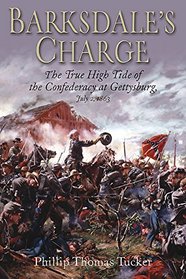Search -
Barksdale's Charge: The True High Tide of the Confederacy at Gettysburg, July 2, 1863
Barksdale's Charge The True High Tide of the Confederacy at Gettysburg July 2 1863
Author:
On the third day of Gettysburg, Robert E. Lee launched a magnificent attack. For pure pageantry it was unsurpassed, and it also marked the centerpiece of the war, both time-wise and in terms of how the conflict had turned a corner?from persistent Confederate hopes to impending Rebel despair. But Pickett?s Charge was crushed by the Union defender... more »
Author:
On the third day of Gettysburg, Robert E. Lee launched a magnificent attack. For pure pageantry it was unsurpassed, and it also marked the centerpiece of the war, both time-wise and in terms of how the conflict had turned a corner?from persistent Confederate hopes to impending Rebel despair. But Pickett?s Charge was crushed by the Union defender... more »
ISBN-13: 9781612002279
ISBN-10: 1612002277
Publication Date: 9/19/2016
Pages: 336
Rating: ?
ISBN-10: 1612002277
Publication Date: 9/19/2016
Pages: 336
Rating: ?
0 stars, based on 0 rating
Publisher: Casemate
Book Type: Paperback
Other Versions: Hardcover
Members Wishing: 1
Reviews: Amazon | Write a Review
Book Type: Paperback
Other Versions: Hardcover
Members Wishing: 1
Reviews: Amazon | Write a Review
Genres:
- History >> Americas >> United States >> Civil War >> Campaigns & Battlefields
- History >> Americas >> United States >> Civil War >> Confederacy




